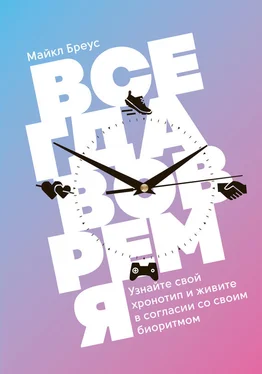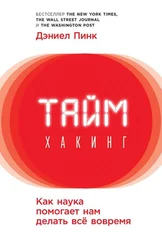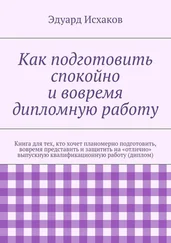Christoph Randler and Lena Salinger, “Relationship Between Morningness-Eveningness and Temperament and Character Dimensions in Adolescents”, Personality and Individual Differences , January 2011.
Margo Hilbrecht, Bryan Smale, and Steven E. Mock, “Highway to Health? Commute Time and Well-Being Among Canadian Adults”, World Leisure Journal , April 2014.
Ángel Correa, Enrique Molina, and Daniel Sanabria, “Effect of Chronotype and Time of Day on Vigilance Decrement During Simulated Driving”, Accident Analysis and Prevention , June 2012.
Adam Martin, Yevgeniy Goryakin, and Marc Suhrcke, “Does Active Commuting Improve Psychological Wellbeing? Longitudinal Evidence g11 Eighteen Waves of the British Household Panel Survey”, Preventive Medicine , December 2014.
Juan Francisco Díaz-Morales, Joseph R. Ferrari, and Joseph R. Cohen, “Indecision and Avoidant Procrastination: The Role of Morningness-Eveningness and Time Perspective in Chronic Delay Lifestyles”, Journal of General Psychology , July 2008.
Correa, Lara, and Madrid, “The Vigilance Decrement in Executive Function Is Attenuated When Individual Chronotypes Perform at Their Optimal Time of Day”.
Farshad Kooti, Luca Maria Aiello, Mihajlo Grbovic, Kristina Lerman, and Amin Mantrach, “Evolution of Conversation in the Age of Email Overload”, International World Wide Web Conference Committee, May 2015.
M. A. Miller, S. D. Rothenberger, et al., “Chronotype Predicts Positive Affect Rhythms Measured by Ecological Momentary Assessment”, Chronobiology International , April 2015.
R. L. Matchock and J. T. Mordkoff, “Chronotype and Time-of-Day Influences on the Alerting, Orienting, and Executive Components of Attention”, Experimental Brain Research , January 2009.
Uri Simonsohn and Francesca Gino, “Daily Horizons: Evidence of Narrow Bracketing in Judgment g11 10 Years of M.B.A. Admissions Interviews”, Psychological Science , May 2012.
L. Carlucci and J. Case, “On the Necessity of U-Shaped Learning”, Topics in Cognitive Science , January 2013.
Pablo Valdez, Candelaria Ramírez, and Aída García, “Circadian Rhythms in Cognitive Performance: Implications for Neuropsychological Assessment”, ChronoPhysiology and Therapy , December 2012.
Christina Schmidt, Fabienne Collette, and Carolin F. Reichert, et al., “Pushing the Limits: Chronotype and Time of Day Modulate Working Memory-Dependent Cerebral Activity”, Frontiers in Neuroscience, September 2015.
Paula Alhola and Päivi Polo-Kantola, “Sleep Deprivation: Impact on Cognitive Performance”, Neuropsychiatric Disease and Treatment , October 2007.
Todd McElroy and David L. Dickinson, “Thoughtful Days and Valenced Nights: How Much Will You Think About the Problem?” Judgment and Decision Making, December 2010.
M. E. Jewett, J. K. Wyatt, et al. “Time Course of Sleep Inertia Dissipation in Human Performance and Alertness”, Journal of Sleep Research, March 1999.
Díaz-Morales, Ferrari, and Cohen, “Indecision and Avoidant Procrastination: The Role of Morningness-Eveningness and Time Perspective in Chronic Delay Lifestyles”.
Seung-Schik Yoo, Peter T. Hu, Ninad Gujar, Ferenc A. Jolesz, and Matthew P. Walker, “A Deficit in the Ability to Form New Human Memories Without Sleep”, Nature Neuroscience , February 2007.
Guang Yang, Cora Sau Wan Lai, Joeseph Cichone, Lei Ma, Wei Li, and Wen-Biao Gan, “Sleep Promotes Branch-Specific Formation of Dendritic Spines After Learning”, Science, June 2014.
Alhola and Polo-Kantola. “Sleep Deprivation: Impact on Cognitive Performance”.
F. F. Barbosa and F. S. Albuquerque, “Effect of the Time-of-Day of Training on Explicit Memory”, Brazilian Journal of Medical and Biological Research , May 2008.
Keith Harris, “A Statistical Analysis of Suggested and Accepted Times for Meetings and Events”, WhenIsGood.net, October 2009.
Paul King and Ralph Behnke, “Patterns of State Anxiety in Listening Performance”, Southern Communication Journal , 2004.
B. J. Shannon, R. A. Dosenbach, et al., “Morning-Evening Variation in Human Brain Metabolism and Memory Circuits” Journal of Neurophysiology , March 2013.
Wieth and Zacks, “Time of Day Effects on Problem Solving: When the Non-Optimal Is Optimal”.
Floris T. Van Vugt, Katharina Treutler, Eckart Altenmüller, and Hans-Christian Jabusch, “The Influence of Chronotype on Making Music: Circadian Fluctuations in Pianists’ Fine Motor Skills”, Frontiers in Human Neuroscience , July 2013.
Ruth Wells, Tim Outhred, James A. J. Heathers, Daniel S. Quintana, Andrew H. Kemp, “Matter Over Mind: A Randomised-Controlled Trial of Single-Session Biofeedback Training on Performance Anxiety and Heart Rate Variability in Musicians”, PLOS One , October 2012.
Jeffrey M. Ellenbogen, Peter T. Hu, Jessica D. Payne, Debra Titone, and Matthew P. Walker, “Human Relational Memory Requires Time and Sleep”, PNAS , March 2007.
Список из сотен вопросов ТОА и текст для самопроверки можно найти на www.remote-associates-test.com.
Сыр.
Лед.
Боль.
Расческа.
Поход.
Бумага.
Рюкзак.
Игра.
Шлюз.
Denise J. Cai, Sarnoff A. Mednick, Elizabeth M. Harrison, Jennifer C. Kanady, and Sara C. Mednick, “REM, not Incubation, Improves Creativity by Priming Associative Networks”, PNAS , May 2009.
Wieth and Zacks, “Time of Day Effects on Problem Solving: When the Non-Optimal Is Optimal”.
Он разделил канат вдоль на две части и связал их.
До нашей эры не использовали сокращение «до н. э.».
На 59-й день. Поскольку количество кувшинок ежедневно удваивается, наполовину озеро будет покрыто днем раньше, перед тем как на 60-й день покроется полностью.
Бобу двенадцать, а его отцу тридцать шесть. Четыре года назад Бобу было четыре, а его отцу – тридцать два.
Читать дальше
Конец ознакомительного отрывка
Купить книгу



![Сергей Семеркин - Когда факс приходит не вовремя [litres самиздат]](/books/436994/sergej-semerkin-kogda-faks-prihodit-ne-vovremya-li-thumb.webp)








